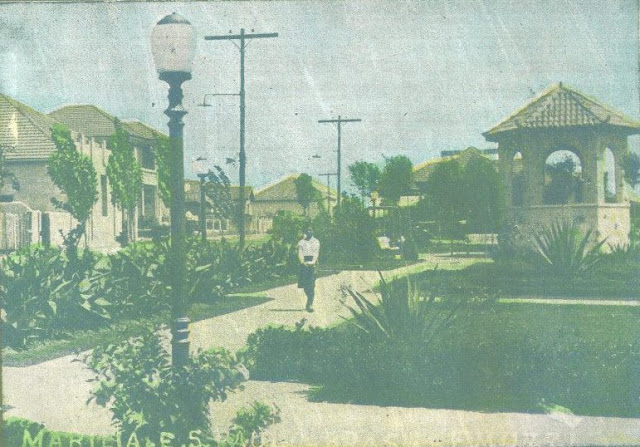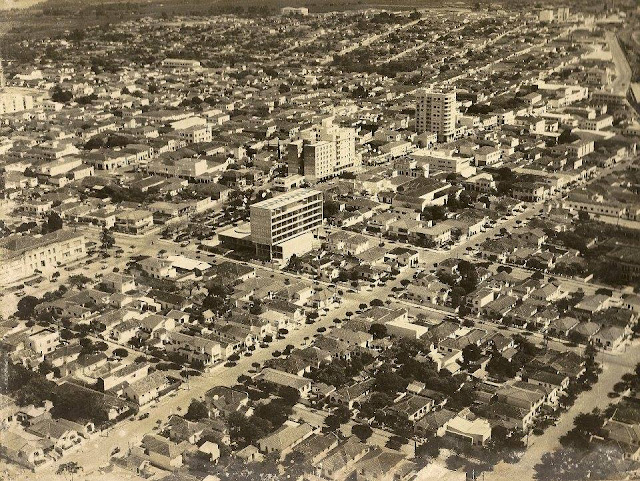Marching on National Holidays like 7 de Setembro was a must in Marilia society in the 1930s, 40s, 50s and even in the early 1960s. Here are some snapshots taken by friends and relations of mainly students marching down Avenida Sampaio Vidal through the years.
Sunday, December 27, 2015
Sunday, October 18, 2015
Afonsinho, a football player.
Osvado Mendes wrote: Minha turma do 2o. Ano Primário no Grupo Escolar Thomaz Antonio Gonzaga em 1954-1955; a professora era dona Elizabeth. Eu sou o 1o. à direita, na 1a. fila (ostentando meu relogião); o 7o. na mesma fila, da esquerda p'ra direita, é o Afonsinho, que se tornaria craque de futebol, no Botafogo do Rio de Janeiro, cantado por Elis Regina nos versos de Gilberto Gil: 'Prezado amigo Afonsinho, eu continuo aqui mesmo...' O Afonsinho hoje é médico. Figuraça!
Afonso Celso Garcia Reis
Afonsinho & Jairzinho in a photo part of an article at Jornal da Tarde 12 February 1971.
read more about Afonsinho at: https://pt.wikipedia.org/wiki/Afonso_Celso_Garcia_Reis
Friday, October 16, 2015
PRAÇA SATURNINO DE BRITO
There is a certain space at the start of the main avenue in Marilia (Avenida Sampaio Vidal) that became a landscaped square in the late 1920s. It was called simply Jardim Publico (public garden) where people congragated on week-ends to socialize or listen to music played by musicians on the bandstand.
Mayor Teodoro da Silva Nogueira gave Jardim Publico a name on 22 September 1933: Praça Saturnino de Brito, one of three young men from Marilia who had lost their lives in the squirmishes with the Brazilian government in the infamous 1932 Constitutionalist Revolution. Nelson Spielmann and Vicente Ferreira are the other two privates who died needlessly because of the irresponsable behaviour of their Army commanders - who, naturally, were never prosecuted.
17 years later, on 1st of May 1950, another mayor, Miguel Argolo Ferrão (UDN) unveiled the statue of private Saturnino de Brito.
We don't know exactly when the bandstand was torn down but by the mid-1950s there was no more bandstand to be seen.
Mayor Teodoro da Silva Nogueira gave Jardim Publico a name on 22 September 1933: Praça Saturnino de Brito, one of three young men from Marilia who had lost their lives in the squirmishes with the Brazilian government in the infamous 1932 Constitutionalist Revolution. Nelson Spielmann and Vicente Ferreira are the other two privates who died needlessly because of the irresponsable behaviour of their Army commanders - who, naturally, were never prosecuted.
17 years later, on 1st of May 1950, another mayor, Miguel Argolo Ferrão (UDN) unveiled the statue of private Saturnino de Brito.
We don't know exactly when the bandstand was torn down but by the mid-1950s there was no more bandstand to be seen.
Here are some photos of that site - with its beautiful bandstand - before it was destroyed gradually by irresponsible mayors in the early 1950s and then almost completely razed to the ground in 1960 when the new City Hall was built.
Jardim Publico
a lonely student who might have missed her classes strolls through the gardens...
here's the original photo not yet artificially colourized.
here's the original photo not yet artificially colourized.
looking west... one can see Edificio Marilia's frame going up in the background...
a view from a different angle in the 1930s. One can see the bandstand in the centre with young trees surrounding it. Praça Saturnino de Brito na esquina da Avenida Sampaio Vidal com rua Bahia (a rua no canto direito); lá no alto, a mata da Fazenda Cascata.
This bandstand saw the likes of band-leader Jorge Galatti in his heyday when 'Saudades de Matão' was his greatest hit.
trees rapidly grew... surrounding the bandstand beautifully...
benches where one could unwind for a while...
trees rapidly grew... surrounding the bandstand beautifully...
benches where one could unwind for a while...
one can see the beautiful Art-Deco building housing Marilia's Gymnasium (Brazilian High School) on the right. 

some rose bushes in the central flower-bed.
the square seen from a high point...
Saturnino de Brito's statue in the mist of a December 1950 morning; photo taken by M.J.Pires.
the square seen from a high point...
Saturnino de Brito's statue in the mist of a December 1950 morning; photo taken by M.J.Pires.
This shot must have been taken in late 1959 just prior to the inauguration of the new City Hall (Paço Municipal); one can see that the praça is still 'intact' with most of its trees all in place (the bandstand had been raised to the ground when they erected the statue honouring Saturnino de Brito much earlier).
aerial view of Marilia taken at the same day of the previous photo... Praça still had trees then...
M.J.Pires took this picture in December 1960. The damage had alredy been done; most trees had been cut down and the praça itself had been whittled down considerably becoming no more than a 'strip' at its East end.
Scorched earth!!! This is what became of the square after 1960.
desolation in the square...
devastation & concrete were 'in' in the early 1960s.
Mansur Lufti wrote at Facebook: Carlus, é estranho porque me lembro muito bem que no começo da década de 1950, nesta parte da Praça voltada para a Av. Rio Branco havia árvores bem altas. Eram os 'jacarandás mimosos', ou castanholas, que dão cachos de flores azuis no início da primavera. Não havia esse Coreto; a banda do maestro Galatti tocava ao rés do chão no outro extremo da Praça sob altas árvores também. A Praça foi destruída para duplicar a Avenida Sampaio Vidal, que nesse trecho tinha pista única; e abrir o trecho da Rua 4 de Abril, que não existia. Só restou uma nesga de terra como mostra a foto acima.
Henrique Nazari wrote at Facebook -19 October 2015: Eu nasci na Colonia Paulista em 1931. Me referindo ao Coreto, me lembro muito dele, pois como era de costume naquela época, aos domingos, após a missa, na igreja de São Bento, uma bandinha famosa, a do saudoso maestro Jorge Galatti, compositor da famosa valsa 'Saudades de Matão', que a molecada chamava de 'A furiosa', após apresentação na igreja, ia tocando pelas ruas até esse Coreto, que ficou na história de Marilia, realizando ai, verdadeiras páginas musicaes.
This is Saturnino de Brito's statue itself... if you look hard at Saturnino's face (right-hand side) you'll notice the 'hidden figure' of Karl Marx 's face in the tree's branches (next to Saturnino's face'.
Wednesday, July 29, 2015
Doctors, politicians, principals, teachers, citizens...
Antonio Artêncio Fo. para Regina Aparecida Perpetuo: posso estar errado, mas o médico do lado esquerdo, de gravata, atrás do que usa óculos e ao lado do médico que está no meio da foto, me parece ser o dr. Antonio Mendes Filho, meu padrinho.
Regina: Sim, o que eu quero saber é o que está atrás dele.
Antonio: em sentido contrário ao dr. Antonio Mendes Filho, não seria o dr. Fernando Mauro?
Regina: Eu achava que era o dr. Pérsio de Carvalho; o de baixo é o dr. Castro. Olha uma foto do dr. Fernando Mauro aqui:
Regina: de todas as fotos do dr. Fernando Mauro essa é a que mais chega perto da minha lembrança dele: o bigode era grosso e os cabelos penteados para trás.
President Juscelino Kubistchek talks to Dr Fernando Mauro in the former's official visit to Marília.
Curso Normal do Instituto Educacional de Marília Reverendo Crisanto Cesar 1954.
Grupo Escolar Thomaz Antonio Gonzaga - 1951.
photo posted at Facebook's Memoria de Marilia by Anna Stella Duarte: from left to right.: minha mãe Ismênia, meu irmãozinho, meu pai, tia Esther e eu - na calçada da Rua Jose Amador Leon, 39.
Ismênia with long tresses holds a baby flanked by two unidentified girls.
Ismênia (at centre) flanked by Cila & Neiva at Fazenda Bonfim.
Anna Stella Duarte & her mother Ismênia in 2016.
Wilson, Idelson & Iris Augusto Wilson on a flat-bed Ford on Rua Paes Leme, Alto Cafezal aka Morro do Querosene in the 1950s. Posted by Yuri Del Torres, those kids' nephew.
Ivan Torres at Tiro de Guerra-1968; posted by his son Yuri Del Torres at facebook.
Ferroviários de Marília
Corbi-Braga writes about this photo at Facebook's 'Memorias de Marilia': Nesta foto tem um grande amigo meu, Benedicto Baptista, que era ferroviário. Muitos dos ferroviários pertenciam ao Partido Comunista Brasileiro. Benedicto é o pernúltimo, à direita, em pé; foi o primeiro negro a ser sócio do Yara Club de Marilia. Vivo até hoje, cuida da netinha, já que sua filha faleceu de cancer.
Liana Eppinghaus Barbalho Silva Teles writes: Que foto linda! E bela história. Sim, eram do Partido Comunista Brasileiro. Certa vez eu estive numa reunião deles, em 1962 ou 1963... éramos idealistas, nós, jovens, pensávamos em mudar o mundo.
Apostolado da Oração - Prayer Apostolate at Saint Benedict in Marilia in the 1940s. Among the faithful are Marina Helena Pisa Sampaio Goes, Sebastiana Camargo Moraes, Francisca da Cunha Sornas, Maria Degani Maguolo, Antonia Mendes Penteado, Maria Jose de Oliveira Faria, Emérita Bonini Reginato, Maria do Carmo Porto Leite. Pe. Luiz Octavio Bicudo de Almeida directed the group. The arrangements at the image of the Sacred Heart were done by Chiquinha Sornas and Maria Borges Costa. Posted at Facebook by Paulo Sergio Fernandes on 14 July 2017.
Note: The lay apostolate is made up from lay people and consecrated religious who exercise a ministry within the Catholic Church. These organizations cooperate with ecclesiastical authorities. They operate 'under directions of her pastors' but are not members of the official Church hierarchy nor in Holy Orders.
Monsignor Luiz Bicudo with Marilia's mayor Dr. Adhemar de Toledo in 1947.
Subscribe to:
Posts (Atom)

















































